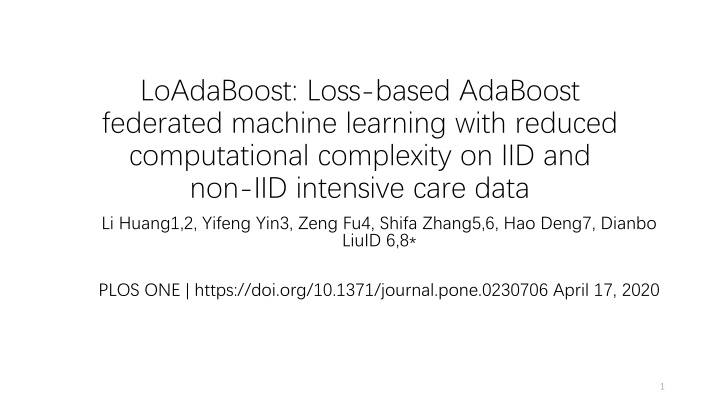
Reduced Complexity Federated Machine Learning for Intensive Care Data
Explore LoAdaBoost, a loss-based AdaBoost federated machine learning approach for intensive care data, offering reduced computational complexity and high privacy. This study focuses on data distributivity, privacy, security, and communication efficiency in the healthcare sector.
Download Presentation

Please find below an Image/Link to download the presentation.
The content on the website is provided AS IS for your information and personal use only. It may not be sold, licensed, or shared on other websites without obtaining consent from the author. If you encounter any issues during the download, it is possible that the publisher has removed the file from their server.
You are allowed to download the files provided on this website for personal or commercial use, subject to the condition that they are used lawfully. All files are the property of their respective owners.
The content on the website is provided AS IS for your information and personal use only. It may not be sold, licensed, or shared on other websites without obtaining consent from the author.
E N D
Presentation Transcript
LoAdaBoost: Loss-based AdaBoost federated machine learning with reduced computational complexity on IID and non-IID intensive care data Li Huang1,2, Yifeng Yin3, Zeng Fu4, Shifa Zhang5,6, Hao Deng7, Dianbo LiuID 6,8* PLOS ONE | https://doi.org/10.1371/journal.pone.0230706 April 17, 2020 1
Motivation and Target Health care data stored distributivity and high privacy Other publish Test accuracy, privacy, security , communication efficiency This publish : Local client-size computation complexity (Main) Communication cost Test accuracy 2
Data Patients drug usage and mortality from Medical Information Mart for Intensive Care (MIMIC-III) eICU Collaborative Research Database With iid and non-iid data-share concept 3
Contribution Application of federated learning to health data LoAdaBoost algorithm has better performance than traditional FedAvg 4
Data shared concept Share a small subset of training data Send these data to client and balance non-iid Little effect about communication and distribution Random fraction ratio of the globally-shared data size to the total client data size 5
Loss function binary cross-entropy X drug feature vector Y binary label survival or die N total number of example f model Target minimize above loss function 6
Main algorithm Description Client send weight and loss to server Server send median loss and FedAvg weight to client At ?? iteration , after E/2 epochs, if ?????< ?????????? training E/2 epochs. ? 1 , continue (Upper bound is 3E/2 epochs) 7
Main algorithm Shadow code Ensure most client s loss lower than prior iteration 8
Experiment settings Data MIMIC-III database Drugs vector table 9
Experiment settings Parameter sets Three hidden layers with 20, 10, 5 units ReLu activation function Adam optimizer n = 0.001, = 1%, 2%, 3%, = 10%, 20% ,30% Epoch = 5 10, 15 Clients selection = 10%, 20%, 50%, 100% Cross validation 10
Experiment settings Evaluation metrics Model accuracy Average epochs T : global round, m: clients participate 11
Experiment result FedAvg with data-shared 12
Experiment result LoAdaboost with iid setting At start, FedAvg training full epochs, converge faster than LoAdaboost Prevent overfitting by training less epochs 13
Experiment result LoAdaboost with iid setting Achieve less average epochs 14
Experiment result LoAdaboost with non-iid setting Distribution = 10%, 20%, 30% Globally shared data size = 1% Client fraction = 10%, epoch E = 5 Learning on non-iid data become more difficult 15
Experiment result LoAdaboost with non-iid setting and different , , C 16
Experiment result eICU dataset description Non-iid dataset Hard to converge (need more epochs) 17
Experiment result eICU dataset 50 or more global rounds Lower accuracy than MIMIC C = 10%, E = 5 18
Conclusion Dynamic epochs (E) can fit different client s data distribution LoAdaBoost FedAvg converged to slightly higher AUCs and fewer average epochs of clients than FedAvg Federated learning with IID data does not always outperform that with non-IID data. In non-iid setting , LoAdaBoost may also lose its competitive advantage 19
